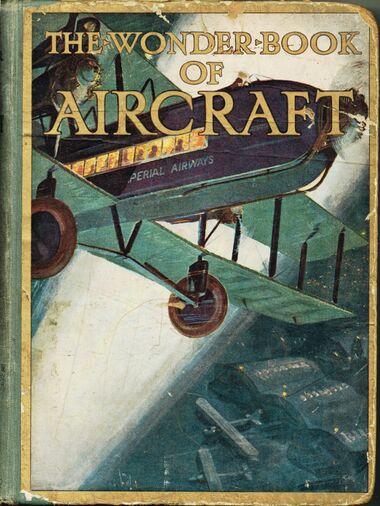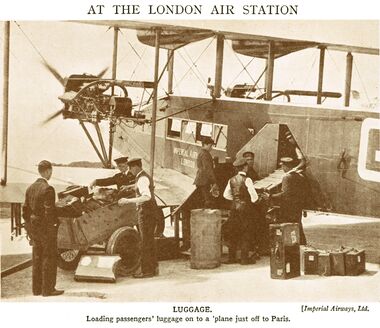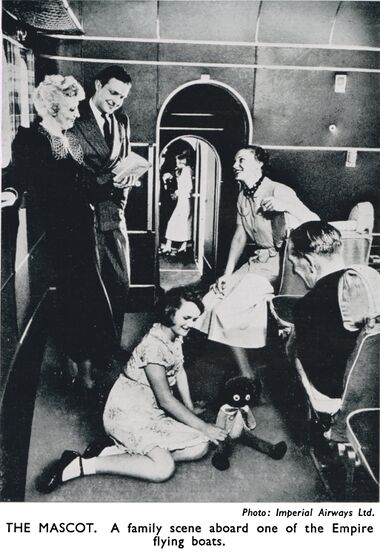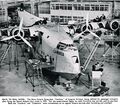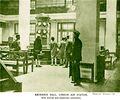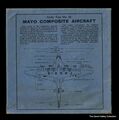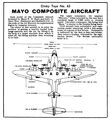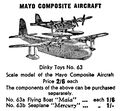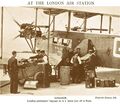Category:Imperial Airways
1928: cover of the Wonder Book pf Aircraft, 6th edition [image info]
1928: Passenger Luggage being stowed, at Croydon [image info]
1938: Of its time: A posed publicity photo showing a family scene onboard an Empire Flying Boat [image info]
With the grouping of Britain's railways in 1923 to produce the "Big Four" now out of the way, in 1924 the government was able to turn its attention to finishing the similar project for Britain's air transport companies, to form Imperial Airways.
Background
The rapid development of large long-distance aircraft (especially large seaplanes) was driving a similarly-rapid growth of long-distance air travel and air mail delivery services. Britain found itself trying to run an Empire that was increasingly dependent on strategic air routes. Since some of these were only marginally profitable and others were subsidised by foreign powers, this threatened to make British international communications dependent on foreign companies whose allegiances were ultimately not to Britain. What was needed was a similarly strategic outlook (and appropriate subsidisation) of British international air services.
By 1924, the position had become so serious that the government appointed a committee (later known as the Hambling Committee) to report on the methods of putting British Air Transport on a sound footing. This committee recommended that if British Air Transport were to survive, let alone develop, then one company and one alone must be entrusted with the task. This report led to the formation of Imperial Airways on March the 31st 1924 as the chosen instrument of the government with the mandate to develop British Air Transport on an economic basis.
— , -, , Aerial Milestones, Imperial Airways 1924 to 1939, Britain Contribution to Air Transport,
Machines Used by Imperial Airliners
Huge Air Liners combine Speed with Luxury
IN the early days of civil aviation the saving in time that could be made by means of an aeroplane was considered sufficient in itself to induce travellers to go by air. Little attention was paid to the comfort of passengers, and in cold weather it was often necessary for them to be wrapped up almost as much as if they were in the cockpit of an open machine. It was soon realised, however, that if the aeroplane were to become really popular it was necessary for air travel to be made as comfortable as any of the ordinary methods of surface transport. From that time steady progress towards comfort has been made, and in these days air liners are quite as pleasant to travel in as the first-class coaches of railway trains. The idea of comfort has been extended also to private flying, and practically all the light aeroplanes that are now produced are of the cabin type, or are provided with special covers that can be put over the cockpits to protect the occupants.
The most luxurious machines built in this country are undoubtedly those that have been designed for operation on the services of Imperial Airways. These types include the Armstrong Whitworth "Argosy" and "Atalanta", the Handley-Page "Heracles", and "Hannibal," and the Short "Scipio" and "Scylla" ...
— , -, , Meccano Magazine, , November 1934
The one goal that we have always set before Imperial Airways is that they should put their operations on a commercial basis and become self-supporting at the earliest possible moment. With that goal in view, the design and number of the Company's air fleet has never been interfered with by the Air Ministry. These matters have been left to the Company and its expert advisers and have been governed solely by principles of strict business economy. The result has been that, with a far smaller subsidy, the Company has now advanced towards an economic basis of operation far ahead of its Continental rivals.
— , Sir Phillip Sassoon, , Some aspects of the Policy of Imperial Airways, , 8th March 1934
SPANNING THE EMPIRE BY AIR
WHEN the two great pioneers of British air transport, Mr. G. Holt Thomas and Mr. F. Handley Page, began to operate the first British air services between London and Paris in 1919, they visualized the time when the entire Empire would be linked by speedy air services. Even before the first passenger 'plane left the ground they were busy with plans for such Empire services.
They did not visualize the difficulties, both financial and political, that would follow the attempts to establish such air services. So great were these difficulties that it was not until the closing days of 1926 that the first real Empire air service was brought into operation, and this was merely a section connecting Cairo in Egypt with Baghdad and Basra in Mesopotamia. It was, however, the forerunner of the great 22,000 miles system now existing.
The work of establishing the Empire airways provided all the elements of romance. They pass across seas, deserts and tropical jungles. Aerodromes had to be hewn out of virgin jungle and built in districts which, in the rainy seasons, are nothing more than swamps.
Rest Houses had to be provided in the very heart of deserts over which roamed hostile Arab tribes, and in the depth of African jungles where wild animals were a constant menace.
Furthermore, there was available no personnel with the necessary technical knowledge for staffing the aerodromes along the route, and the Empire airways have brought into being a new career for youths, that of Airway Station Master, but they have first to be trained in all the various branches of air transport. When the political and financial difficulties in connection with the establishment of the London—India air route had been overcome, a vast amount of organization was immediately undertaken. Special air-liners, designed and equipped for operation in the peculiar climatic and geographical conditions existing along these routes, were designed and built. A large section of the route ran over deserts, and the aircraft had to be designed and fitted with suitable equipment in order that their passengers should be safe even should they have to alight in the heart of these deserts, hundreds of miles from human habitation.
Special wireless apparatus was fixed in the air-liners. In addition they were equipped with collapsible wireless masts, while small petrol engines, driving dynamos to supply power for the wireless, were installed. By use of this special installation, the pilots could communicate with civilization in the event of a forced landing in the desert.
"Iron" rations were carried on each air-liner, together with an adequate supply of water to enable the passengers and crews to exist until succour arrived.
It is, perhaps, as well to mention in passing that on only two occasions has the necessity arisen for the use either of these special wireless facilities or of the "iron" rations.
As it was impossible to cross the entire desert in one day, a Rest House had to be provided as a half-way halt. This was in the heart of desert country infested by hostile Arab tribes, and was, therefore, built in the form of a fort, strong enough to keep at bay any possible attack from Arab marauders. Here, again, the fort has never been used for war-like purposes, its very existence being sufficient to deter attack.
Part of the route to India involves the crossing of the Mediterranean, and big passenger flying-boats were designed and built to accomplish the flight over this section. These machines were far in advance of their time, and are to-day perhaps the finest example of passenger flying-boats in the world.
So efficient is their design that they are only taken out of the water into sheds for overhaul at long intervals, it being possible even to change the engines while the flying-boats are moored on the water in harbour.
By March 1929 the complete route from London to India was in operation, but further difficulties prevented its extension beyond Karachi until 1933, when the route was extended stage by stage across India and through Burma and Malaya to Singapore. Another section taking the route right through to Brisbane in Australia was inaugurated in 1934. This London—Brisbane air service is the longest in the world, having a route mileage of 13,000.
The original aircraft used on this route flew at an average speed of 100 miles an hour, but in the years that passed before the service was extended, flying speeds had risen. As a result, when the extensions from Karachi to Singapore were inaugurated, aircraft capable of 150 miles an hour were specially built, and put into service on this section; while the final link, from Singapore to Australia, was opened with four-engined air-liners capable of speeds in excess of 175 miles an hour.
To-day, in fact, all the Empire routes are operated by four-engined air-liners, whose speeds range from 100 to 175 miles an hour.
Luxury, too, had increased faster perhaps than speed, and now the air-liners and flying-boats operating on Empire routes are so large that they are able to carry stewards, who serve meals to passengers in flight. Experiments are now actually being made with the object of equipping the air-liners with sleeping berths, in order that passengers may be flown by night as well as by day.
By 1932 agreements had been reached with the various British countries in Africa, which enabled an 8,000 miles air service to be operated right through from London to Cape Town. This was the first service to cross the Equator, and is undoubtedly the most romantic of any air-line in the world. It passes across the deserts of Northern Africa with their monuments and relics of ancient Egypt, over the great swamp area of the Sudan, teeming with elephants, herds of which can be seen from the air, along the great lakes to Central Africa, and over the big-game lands in Kenya and Tanganyika, to the vast South African veld.
Along this route the airway staff wage constant war with the wild life of Africa, both vegetable and animal, a war which is intensified by the vagaries of the climate.
In the dry seasons the heat in places is terrific and the aerodromes become scorched and barren. With the coming of the rains vigorous tropical vegetation springs up and threatens to overrun the aerodromes, and gangs of natives are required to be constantly at work to keep them clear and allow the air-liners to alight in safety.
Many of the aerodromes almost revert to their original condition of swamp during the rainy seasons and special processes have had to be devised to provide hard runways on which the aeroplanes can alight, and which will remain firm even in the heaviest rain.
Some of the aerodromes are surrounded by a game-proof fence to keep off marauding lions. Elephants have been known to lean against the posts carrying telephone and electric light wires, and push them over. A roaming hippopotamus on one occasion made a meal of the grass thatching of the aerodrome buildings, and warthogs, invading an aerodrome in large numbers, plough it up with their snouts in a single night.
Insect life also is troublesome. Mosquitoes abound and ants burrow under the aerodrome and throw up ant-hills which rise to a height of as much as 25 feet.
In spite of all these drawbacks, however, the air service through Africa operates with clockwork regularity, a striking tribute to the organization and efficiency of the airway staffs.
So regular is the service, in fact, that police officers in various parts of Africa now find the natives fixing the date of a crime, about which they are being questioned, by statements such as " it was two days after the aeroplane passed flying north. . . ."
The success of these great Empire routes has brought additional prosperity and luxury to the countries along their routes. Not only have they enabled journeys of weeks to be reduced to hours, but they are also the means of ensuring regular supplies of fresh food and luxuries to those living hundreds of miles from the nearest source of supply. In one case the baker of a small township in the heart of Africa now obtains regular supplies of fresh yeast by air-mail.
Nearly 100,000 letters a week are now carried by these Empire air services, and the rapidity with which letters can be received, not only from the Mother Country but from other parts of the Empire, and the feeling of nearness which the speed of the air-mail inspires, has undoubtedly resulted in knitting the Empire still closer.
— , R. BRENARD, , The Wonder Book of Aircraft, 8th edition, , ~1934
The year 1924 is specially notable in the development of organized air transport in the British Empire, because the subsidized company Imperial Airways, Ltd., was formed then to amalgamate the four existing British air transport companies into a national body with a view to concentrating on Empire air services. Its foundation was an event of importance in the development of air travel, and in the first six years of its existence it established a record of efficiency, reliability and safety which was unsurpassed by any similar organization. The record has been well maintained, and considerable progress has been made in the extension of the Company's air routes throughout the Empire. …
— , M.J.B. Davy, , Interpretative History of Flight, , 1937
It is with regard to the latter that we are most concerned in this country. The aeroplane — and perhaps the airship — by providing rapid communication between the countries in the British Empire can render a service which is vital to progress. This probably represents the most profitable of all the uses to which the aeroplane may be put, because the distances are very great and the existing communications, in regard to speed, inadequate. The linking of these several countries by air represents a profound achievement because it is directed towards the solution of a major problem — that of unrestricted and rapid intercourse between the peoples of the world. When we reflect that the air services of the British Empire operate not within the frontiers of one country or the limits of one continent but traverse four continents and some thirty countries, the achievement obtains an even greater significance. The operation of such services presents many difficulties, arising from the acute nationalism which has developed in many countries during recent years; national prejudices resulting from the play of international politics have to be overcome and agreement with the various foreign governments secured. The state of the world to-day, and particularly Europe, is not conducive to the successful development of international air transport, and until the principle of freedom of the air — on the analogy of the earlier freedom of the seas – is conceded, the greatest use cannot be made of the power of flight. It is remarkable that so much has already been accomplished.
— , M.J.B. Davy, , Interpretative History of Flight, , 1937
1933 information
Some facts about Imperial Airways
- It serves three continents and twenty-two countries
- It operates two regular services a week from London to Cairo with weekly extensions from these right across India and Burma to Rangoon and through Africa to Cape Town. The India and Eastern Service will be extended from Rangoon to Singapore in December
- It operates regular daily services to Paris, Brussels and Cologne and during the summer to Basle and to Zürich and a week-end service to Le Touquet
- The route mileage operated by the company is over twelve thousand five hundred
- The company owns a fleet of forty air liners of a total horse power of sixty thousand
- This fleet flies over two million miles a year, which is more than eighty times round the world at the equator
- The Company carries nearly a quarter of a million letters a week on its various services
- The Company employs on its staff over fourteen different nationalities excluding numbers of African and Asiatic natives
- The Company maintains bank accounts in ten currencies and has ledger accounts in twenty-five
- The Heracles class of air liners used between London and Paris are the largest and most comfortable in the world. They are so quiet that you can talk without raising your voice. They carry two stewards, who will serve you with table d'hôte or à la carte meals. There is ample luggage accommodation on board and two lavatories.
— , Imperial Airways, , The Chairman of Imperial Airways said ..., , 1933
External links
Subcategories
This category has the following 8 subcategories, out of 8 total.
A
- Armstrong Whitworth Argosy (2 P, 4 F)
- Atalanta (Armstrong Whitworth) (5 P, 10 F)
C
- Croydon Airport (17 F)
D
- De Havilland Express (2 P, 4 F)
H
- Handley Page HP42 Hannibal and Heracles (3 P, 10 F)
S
- Short S-17 Kent Flying Boat (empty)
- Short Scylla (empty)
Pages in category ‘Imperial Airways’
The following 11 pages are in this category, out of 11 total.
H
I
Media in category ‘Imperial Airways’
The following 34 files are in this category, out of 34 total.
- Armstrong Whitworth Argosy G-EBLF, leaving Croydon (WBoA 6ed 1928).jpg 3,000 × 2,202; 1.11 MB
- Armstrong Whitworth Argosy, Card No 03 (JPAeroplanes 1935).jpg 3,000 × 1,529; 660 KB
- Armstrong-Whitworth Ensign G-ADSR, Imperial Airways (PowerSpeed 1938).jpg 3,000 × 1,668; 1.15 MB
- Cambria, Short Empire Flying Boat (PowerSpeed 1938).jpg 3,000 × 2,668; 1.84 MB
- Canopus Empire Flying Boat G-ADHL, Imperial Airways (IHoF 1937).jpg 3,000 × 1,932; 1.37 MB
- Canopus Empire Flying Boat G-ADHL, on the Medway (PowerSpeed 1938).jpg 3,000 × 1,661; 1.08 MB
- Coriolanus, Empire Flying Boat G-AETV, Imperial Airways (PowerSpeed 1938).jpg 3,000 × 1,212; 595 KB
- Empire Flying Boat, Dinky Toys 60r (MeccanoCat 1939-40).jpg 1,181 × 882; 141 KB
- Empire Flying Boats, box lid (Dinky Toys 60r).jpg 2,429 × 3,000; 1.21 MB
- Ensign airliner G-ADSR, Imperial Airways (PowerSpeed 1938).jpg 3,000 × 1,423; 896 KB
- Entrance Hall, London Air Station, Croydon (WBoA 6ed 1928).jpg 3,000 × 2,494; 1.55 MB
- Family scene, Imperial Airways (PowerSpeed 1938).jpg 2,051 × 3,000; 1 MB
- Handley Page 42, Card No 31 (GPAviation 1938).jpg 2,400 × 1,254; 342 KB
- Handley Page Hannibal G-AAGX, Imperial Airways (MM 1931-04).jpg 3,000 × 2,176; 973 KB
- Handley Page Hannibal G-AAGX, side view, Imperial Airways (MM 1931-04).jpg 3,000 × 1,406; 920 KB
- Handley Page Heracles, Card No 14 (JPAeroplanes 1935).jpg 3,000 × 1,529; 606 KB
- Hanno, HP-42 Heracles-Class G-AAUD (WBoA 8ed 1934).jpg 3,000 × 2,212; 927 KB
- Helena, HP-42 Heracles-Class G-AAXF (WBoA 8ed 1934).jpg 3,000 × 1,966; 796 KB
- Hengist, HP-42 Heracles-Class airliner G-AAXE, Imperial Airways (WBoA 8ed 1934).jpg 3,000 × 2,173; 986 KB
- Hengist, HP-42 Heracles-Class G-AAXE (WBoA 8ed 1934).jpg 3,000 × 2,321; 1.08 MB
- Heracles biplane airliner G-AAXC.jpg 1,800 × 1,200; 1,023 KB
- Hercules DH-66 biplane, Imperial Airways (WBoA 6ed 1928).jpg 3,000 × 1,530; 1,020 KB
- Imperial Airways Frobisher Class Liner, Dinky Toys 62w (MM 1940-07).jpg 2,310 × 1,812; 316 KB
- Mayo Composite Aircraft, box lid (Dinky Toys 63).jpg 2,969 × 3,000; 1.69 MB
- Mayo Composite Aircraft, box lid artwork (Dinky Toys No63).jpg 2,770 × 3,000; 762 KB
- Mayo Composite Aircraft, Dinky Toys 63 (MCat 1939).jpg 1,444 × 878; 122 KB
- Mayo Composite Aircraft, Dinky Toys 63 (MM 1940-07).jpg 2,168 × 2,008; 423 KB
- Mayo Composite and Fairey Sea Fox at Felixstowe (PowerSpeed 1938).jpg 3,000 × 1,421; 919 KB
- Mayo Composite, side view (PowerSpeed 1938).jpg 3,000 × 1,540; 930 KB
- MM-Section Air News 2.jpg 2,182 × 711; 535 KB
- Passenger Luggage, Croydon (WBoA 6ed 1928).jpg 3,000 × 2,593; 1.55 MB
- Passengers boarding an Armstrong Whitworth Argosy G-EBOZ at Croydon (WBoA 6ed 1928).jpg 3,000 × 1,950; 955 KB
- Short-Mayo Composite Aircraft, jigsaw (Victory MA2).jpg 3,000 × 2,336; 1.88 MB
- Wonder Book of Aircraft, Imperial Airways (WBoA 6ed 1928).jpg 2,253 × 3,000; 1.78 MB
